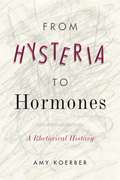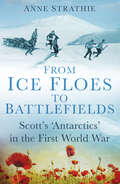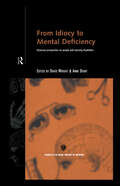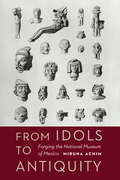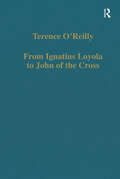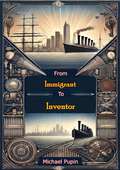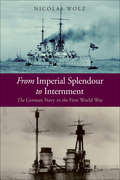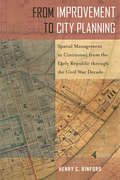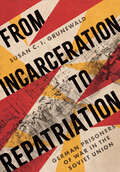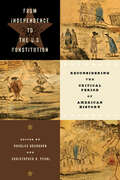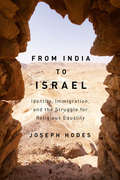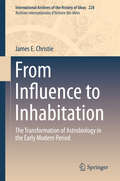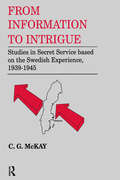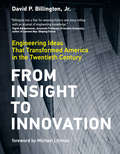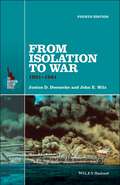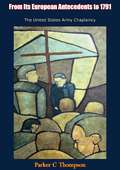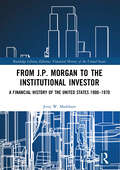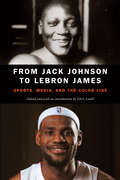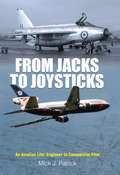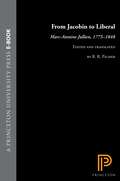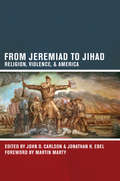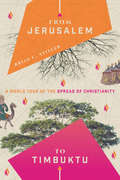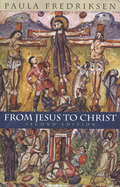- Table View
- List View
From Hysteria to Hormones: A Rhetorical History (RSA Series in Transdisciplinary Rhetoric #7)
by Amy KoerberIn From Hysteria to Hormones, Amy Koerber examines the rhetorical activity that preceded the early twentieth-century emergence of the word hormone and the impact of this word on expert understandings of women’s health.Shortly after Ernest Henry Starling coined the term “hormone” in 1905, hormones began to provide a chemical explanation for bodily phenomena that were previously understood in terms of “wandering wombs,” humors, energies, and balance. In this study, Koerber posits that the discovery of hormones was not so much a revolution as an exigency that required old ways of thinking to be twisted, reshaped, and transformed to fit more scientific turn-of-the-century expectations of medical practices. She engages with texts from a wide array of medical and social scientific subdisciplines; with material from medical archives, including patient charts, handwritten notes, and photographs from the Salpêtrière Hospital, where Dr. Jean Charcot treated hundreds of hysteria patients in the late nineteenth century; and with current rhetorical theoretical approaches to the study of health and medicine. In doing so, Koerber shows that the boundary between older, nonscientific ways of understanding women’s bodies and newer, scientific understandings is much murkier than we might expect.A clarifying examination of how the term “hormones” preserves key concepts that have framed our understanding of women’s bodies from ancient times to the present, this innovative book illuminates the ways in which the words we use today to discuss female reproductive health aren’t nearly as scientifically accurate or socially progressive as believed. Scholars of rhetoric, gender studies, and women’s health will find Koerber’s work provocative and valuable.
From Ice Floes to Battlefields: Scott’s ‘Antarctics’ in the First World War
by Anne StrathieFebruary 1912: Harry Pennell and his Terra Nova shipmates brave storms and ice to bring supplies to Antarctica. They hope to celebrate Captain Scott’s conquest of the South Pole, but are forced by ice to return north before Scott’s party returns. In New Zealand a reporter tells them that Roald Amundsen reached the Pole first. Returning to Antarctica in early 1913, they learn that Scott’s party reached the Pole but died on the ice shelf. Back in Britain memorial services, medal ceremonies, weddings and resumed careers are abruptly interrupted by the First World War. Fit and able men, Scott’s ‘Antarctics’ trade one adventure for another. By 1919 Scott’s ‘Antarctics’ have fought at Antwerp, the Western Front, Gallipoli, in the Channel, at Jutland and in Arctic Russia. They serve on horseback, in trenches, on battleships and hospital ships, in armoured cars and flimsy aircraft; their brothers-in-arms include a prime minister’s son and poet Rupert Brooke. As in Antarctica, life is challenging and dangerous. As on the ice, not all survive.
From Idiocy to Mental Deficiency: Historical Perspectives on People with Learning Disabilities (Routledge Studies in the Social History of Medicine)
by David Wright Anne DigbyFrom Idiocy to Mental Deficiency is the first book devoted to the social history of people with learning disabilities in Britain. Approaches to learning disabilities have changed dramatically in recent years. The implementation of 'Care in the Community', the campaign for disabled rights and the debate over the education of children with special needs have combined to make this one of the most controversial areas in social policy today. The nine original research essays collected here cover the social history of learning disability from the Middle Ages through the establishment of the National Health Service. They will not only contribute to a neglected field of social and medical history but also illuminate and inform current debates. The information presented here will have a profound impact on how professionals in mental health, psychiatric nursing, social work and disabled rights understand learning disability and society's responses to it over the course of history.
From Idols to Antiquity: Forging the National Museum of Mexico (The Mexican Experience)
by Miruna AchimFrom Idols to Antiquity explores the origins and tumultuous development of the National Museum of Mexico and the complicated histories of Mexican antiquities during the first half of the nineteenth century. Following independence from Spain, the National Museum of Mexico was founded in 1825 by presidential decree. Nationhood meant cultural as well as political independence, and the museum was expected to become a repository of national objects whose stories would provide the nation with an identity and teach its people to become citizens.Miruna Achim reconstructs the early years of the museum as an emerging object shaped by the logic and goals of historical actors who soon found themselves debating the origin of American civilizations, the nature of the American races, and the rightful ownership of antiquities. Achim also brings to life an array of fascinating characters—antiquarians, naturalists, artists, commercial agents, bureaucrats, diplomats, priests, customs officers, local guides, and academics on both sides of the Atlantic—who make visible the rifts and tensions intrinsic to the making of the Mexican nation and its cultural politics in the country’s postcolonial era.
From Ignatius Loyola to John of the Cross: Spirituality and Literature in Sixteenth-Century Spain (Variorum Collected Studies)
by Terence O'ReillyThe 16th century saw the rise of movements of religious reform which, in Spain as elsewhere, contributed to make the history of the period such a ferment. In these essays Terence O’Reilly is concerned with the writings produced by these movements, notably Illuminism, the early Jesuits, Erasmianism, and the Carmelite reform, and with the mixture of medieval and new literary conventions that they display. The book first deals with Ignatius Loyola and his Spiritual Exercises, examining its origins in his experience of conversion and the books he read, and locating him not in the period of the militant Counter-Reform, but in an earlier world, linked to the teachings of 16th Spanish Erasmians and illuminists. One study, hitherto unpublished, presents the lost treatise in which the Dominican Melchor Cano argued that Ignatius was an alumbrado. The following sections move to the later the century, considering the connections between spirituality and literature in works such as the ode to Salinas and, above all, in the mystical poetry of John of the Cross and its basis in exegesis and liturgical and devotional texts.
From Immigrant to Inventor: and Pioneer of Electrical Transmission and the Long-Distance Telephone Line
by Michael Idvorsky PupinFrom Immigrant to Inventor is the inspiring autobiography of Michael Idvorsky Pupin, chronicling his extraordinary journey from a modest childhood in rural Serbia to becoming a distinguished scientist, inventor, and professor in the United States. Originally published in 1923, the book offers a personal and reflective narrative of perseverance, intellectual discovery, and the immigrant experience during a transformative era in American history.Pupin begins with memories of his upbringing in a Serbian village, where curiosity about the natural world first sparked his lifelong passion for learning. He then recounts his emigration to the United States as a young man, arriving with little more than determination and dreams of an education. The narrative unfolds with his struggles to adapt to a new culture, working tirelessly to fund his studies and overcome the challenges of poverty.Central to the story is Pupin’s education at Columbia University and further scientific training in Europe, where he immersed himself in physics, mathematics, and engineering. The book traces his groundbreaking inventions in telecommunication and electrical transmission—work that played a pivotal role in advancing wireless communication and earning him numerous patents and accolades, including the Pulitzer Prize for this very memoir.Beyond recounting his personal achievements, Pupin reflects on the broader themes of science, innovation, and the opportunities available to immigrants in America. He emphasizes the importance of education, hard work, and resilience, inspiring readers with his belief that adversity can be a catalyst for greatness.A blend of memoir, science, and philosophy, From Immigrant to Inventor offers a timeless exploration of the immigrant spirit and the transformative power of knowledge. It is a compelling read for those interested in the history of technology, the immigrant experience, and the life of one of the most influential inventors of the 20th century.
From Imperial Splendour to Internment: The German Navy in the First World War
by Nicolas WolzThis important new work describes how the Imperial German Navy, which had expanded to become one of the great maritime forces in the world, second only to the Royal Navy, proved, with the exception of its submarines, to be largely ineffective throughout the years of conflict.The impact of this impotence had a far-reaching effect upon the service. Germany, indeed most of Europe, was in the grips of a spirit of militant nationalistic fervour, and the inactivity of the great Imperial Navy caused deep frustration, particularly among the naval officers. Not only were they unable to see themselves as heroes, they were also ridiculed on the home front and felt profoundly humiliated. With the exception of the one sea battle at Jutland, their ships saw little or no action at sea and morale slowly collapsed to a point where, at the end of the war, the crews were in a state of mutiny. The seemingly ludicrous order that forced the fleet to go to sea against the British in 1918 was driven by a sense of humiliation, but coming at the war's end it triggered a revolution because the German sailors wanted no part in such madness. The internment at Scapa Flow was the ultimate shaming. This is a fascinating and perceptive analysis of a whole era, and it contributes substantially to our understanding of the war and its consequences consequences, sadly, that helped pave the way for the Third Reich.
From Improvement to City Planning: Spatial Management in Cincinnati from the Early Republic through the Civil War Decade (Urban Life, Landscape and Policy)
by Henry C. BinfordFrom Improvement to City Planning emphasizes the ways people in nineteenth-century America managed urban growth. Historian Henry Binford shows how efforts to improve space were entwined with the evolution of urban governance (i.e., regulation)—and also influenced by a small group of advantaged families. Binford looks specifically at Cincinnati, Ohio, then the largest and most important interior city west of the Appalachian Mountains. He shows that it was not just industrialization, but also beliefs about morality, race, health, poverty, and “slum” environments, that demanded an improvement of urban space. As such, movements for public parks and large-scale sanitary engineering in the 1840s and ’50s initiated the beginning of modern city planning. However, there were limitations and consequences to these efforts.. Many Americans believed that remaking city environments could also remake citizens. From Improvement to City Planning examines how the experiences of city living in the early republic prompted city dwellers to think about and shape urban space.
From Incarceration to Repatriation: German Prisoners of War in the Soviet Union (Battlegrounds: Cornell Studies in Military History)
by Susan C. GrunewaldFrom Incarceration to Repatriation explores the lives and memories of the nearly 1.5 million German POWs who were held by the Soviet Union during and after World War II and released in phases through 1956, seven years longer than the prisoners of any other Allied nation. Susan C. I. Grunewald argues that Soviet leadership deliberately kept able-bodied German POWs to supplement their labor force after the end of the war. The Soviet Union lost 27 million citizens and a quarter of its physical assets during the war, motivating Soviet leadership to harness the labor of German POWs for as long as possible. Engaging with recently declassified documents in former Soviet archives, archival material from multiple German governments, as well as innovative use of digital humanities methods and geographic information system (GIS) mapping, Grunewald demonstrates that Soviet authorities detained German POWs primarily for economic rather than punitive reasons. In fact, the GIS mapping of the historical materials makes it clear that most of the four thousand POW camps across the USSR were strategically located near industrial, infrastructure, and natural resource sites that were critical to postwar economic reconstruction. From Incarceration to Repatriation is the first book to draw together the distinct fields of Soviet and German history to provide a more nuanced and comprehensive understanding of German POW captivity in the USSR during and after World War II. Attending to the ways that the memory of German POWs remains in circulation in both the former Soviet Union and Germany, Grunewald tracks the political repercussions of war commemoration.
From Independence to the U.S. Constitution: Reconsidering the Critical Period of American History (Early American Histories)
by Douglas Bradburn Christopher R. PearlThe "Critical Period" of American history—the years between the end of the American Revolution in 1783 and the ratification of the U.S. Constitution in 1789—was either the best of times or the worst of times. While some historians have celebrated the achievement of the Constitutional Convention, which, according to them, saved the Revolution, others have bemoaned that the Constitution’s framers destroyed the liberating tendencies of the Revolution, betrayed debtors, made a bargain with slavery, and handed the country over to the wealthy.This era—what John Fiske introduced in 1880 as America’s "Critical Period"—has rarely been separated from the U.S. Constitution and is therefore long overdue for a reevaluation on its own terms. How did the pre-Constitution, postindependence United States work? What were the possibilities, the tremendous opportunities for "future welfare or misery for mankind," in Fiske’s words, that were up for grabs in those years? The scholars in this volume pursue these questions in earnest, highlighting how the pivotal decade of the 1780s was critical or not, and for whom, in the newly independent United States.As the United States is experiencing another, ongoing crisis of governance, reexamining the various ways in which elites and common Americans alike imagined and constructed their new nation offers fresh insights into matters—from national identity and the place of slavery in a republic, to international commerce, to the very meaning of democracy—whose legacies reverberated through the nineteenth and twentieth centuries and into the present day.Contributors:Kevin Butterfield, Fred W. Smith National Library for the Study of George Washington at Mount Vernon * Hannah Farber, Columbia University * Johann N. Neem, Western Washington University * Dael A. Norwood, University of Delaware * Susan Gaunt Stearns, University of Mississippi * Nicholas P. Wood, Spring Hill College
From India to Israel: Identity, Immigration, and the Struggle for Religious Equality (McGill-Queen's Studies in the History of Religion #2)
by Joseph HodesBetween May 1948 and December 1951, Israel received approximately 684,000 immigrants from across the globe. The arrival of so many ethnic, linguistic, and cultural groups to such a small place in such a short time was unprecedented and the new country was ill-prepared to absorb its new citizens. The first years of the state were marked by war, agricultural failure, a housing crisis, health epidemics, a terrible culture clash, and a struggle between the religious authorities and the secular government over who was going to control the state. In From India to Israel, Joseph Hodes examines Israel's first decades through the perspective of an Indian Jewish community, the Bene Israel, who would go on to play an important role in the creation of the state. He describes how a community of relatively high status and free from persecution under the British Raj left the recently independent India for fear of losing status, only to encounter bias and prejudice in their new country. In 1960, a decision made by the religious authorities to ban the Bene Israel from marrying other Jews on the grounds that they were not "pure Jews" set in motion a civil rights struggle between the Indian community and the religious authority with far-reaching implications. After a drawn-out struggle, and under pressure from both the government and the people, the Bene Israel were declared acceptable for marriage. A detailed look at how one immigrant community fought to maintain their place within a religion and a society, From India to Israel raises important questions about the state of Israel and its earliest struggles to absorb the diversity in its midst.
From Influence to Inhabitation: The Transformation of Astrobiology in the Early Modern Period (International Archives of the History of Ideas Archives internationales d'histoire des idées #228)
by James E. ChristieThis book describes how and why the early modern period witnessed the marginalisation of astrology in Western natural philosophy, and the re-adoption of the cosmological view of the existence of a plurality of worlds in the universe, allowing the possibility of extraterrestrial life. Founded in the mid-1990s, the discipline of astrobiology combines the search for extraterrestrial life with the study of terrestrial biology – especially its origins, its evolution and its presence in extreme environments. This book offers a history of astrobiology's attempts to understand the nature of life in a larger cosmological context. Specifically, it describes the shift of early modern cosmology from a paradigm of celestial influence to one of celestial inhabitation. Although these trends are regarded as consequences of Copernican cosmology, and hallmarks of a modern world view, they are usually addressed separately in the historical literature. Unlike others, this book takes a broad approach that examines the relationship of the two. From Influence to Inhabitation will benefit both historians of astrology and historians of the extraterrestrial life debate, an audience which includes researchers and advanced students studying the history and philosophy of astrobiology. It will also appeal to historians of natural philosophy, science, astronomy and theology in the early modern period.
From Information to Intrigue: Studies in Secret Service Based on the Swedish Experience, 1939-1945 (Studies In Intelligence Ser.)
by C.G. McKayThis volume offers an account of some key activities of the Allied secret services and their German counterparts in Sweden during World War II. It also describes in some detail Swedish wartime legislation and Swedish organizations concerned with internal security and intelligence.
From Insight to Innovation: Engineering Ideas That Transformed America in the Twentieth Century
by David P. BillingtonThe engineering ideas behind key twentieth-century technical innovations, from great dams and highways to the jet engine, the transistor, the microchip, and the computer.Technology is essential to modern life, yet few of us are technology-literate enough to know much about the engineering that underpins it. In this book, David P. Billington, Jr., offers accessible accounts of the key twentieth-century engineering innovations that brought us into the twenty-first century. Billington examines a series of engineering advances--from Hoover Dam and jet engines to the transistor, the microchip, the computer, and the internet--and explains how they came about and how they work.
From Isolation to War: 1931-1941 (The American History Series #23)
by Justus D. Doenecke John E. WilzThe new edition of this popular and widely-used American history textbook has been thoroughly updated to include a wealth of new scholarship on American diplomacy in the decade leading up to Japan’s attack on Pearl Harbor. Features new material on the Washington Conference of 1921-22, early American diplomacy in the Manchurian crisis, the Panay incident, Russia’s invasion of Finland, the destroyer-bases deal, and much more Pays particular attention to Roosevelt’s policies towards Jewish refugees, the battle between domestic groups like the America First Committee and Fight for Freedom, and the Welles mission of 1940 Includes concise biographical sketches of major world leaders, including Hoover, FDR, Churchill, Hitler, Stalin, Mussolini, and Tojo Outlines and examines the debates of historians over the wisdom of U.S. policies
From Its European Antecedents to 1791 The United States Army Chaplaincy
by Parker C ThompsonThis volume is one of a series of five prepared by various authors, designed to be useful and instructive regarding the long history of the United States Army Chaplaincy. The emphasis throughout is on how chaplains did their ministry in the contexts of both war and peace. The series seeks to present as full and as balanced an account as limitations of space and research time permit. The bibliography in each volume offers opportunities for further research. The author of this volume is Chaplain Parker C. Thompson, a Regular Army chaplain of the Southern Baptist Convention. He is a native of Missouri, and entered on active duty as a chaplain in 1952. He has served at Camp Atterbury, Indiana; Fort Leonard Wood, Missouri; Fort Knox, Kentucky; US Army Chaplain Center and School, Fort Hamilton, New York; Fort Dix, New Jersey; and overseas in Korea, Germany, and Vietnam. He has been awarded the Legion of Merit, the Bronze Star Medal (Valor) with 2 Oak Leaf Clusters, the Meritorious Service Medal, the Air Medal, the Army Commendation Medal with 1 Oak Leaf Cluster, and the Purple Heart with 1 Oak Leaf Cluster.
From J.P. Morgan to the Institutional Investor: A Financial History of the United States 1900–1970 (Financial History of the United States)
by Jerry W. MarkhamOriginally published in 2002, this is the second of three volumes in a history of finance in America. This volume starts with the investment bankers who dominated finance at the beginning of the twentieth century. It then describes the Panic of 1907 and the resulting creation of the Federal Reserve Board (the 'Fed'). The volume then traces finance through World War I, and it examines the events that led to the stock market crash of 1929 and the Great Depression. From there it reviews the rebirth of finance after World War II and the growth of the institutional investor.
From Jack Johnson to LeBron James: Sports, Media, and the Color Line
by Chris LambThe campaign for racial equality in sports has both reflected and affected the campaign for racial equality in the United States. Some of the most significant and publicized stories in this campaign in the twentieth century have happened in sports, including, of course, Jackie Robinson in baseball; Jesse Owens, Tommie Smith, and John Carlos in track; Arthur Ashe in tennis; and Jack Johnson, Joe Louis, and Muhammad Ali in boxing. Long after the full integration of college and professional athletics, race continues to play a major role in sports. Not long ago, sportswriters and sportscasters ignored racial issues. They now contribute to the public’s evolving racial attitudes on issues both on and off the field, ranging from integration to self-determination to masculinity.From Jack Johnson to LeBron James examines the intersection of sports, race, and the media in the twentieth century and beyond. The essays are linked by a number of questions, including: How did the black and white media differ in content and context in their reporting of these stories? How did the media acknowledge race in their stories? Did the media recognize these stories as historically significant? Considering how media coverage has evolved over the years, the essays begin with the racially charged reporting of Jack Johnson’s reign as heavyweight champion and carry up to the present, covering the media narratives surrounding the Michael Vick dogfighting case in a supposedly post-racial era and the media’s handling of LeBron James’s announcement to leave Cleveland for Miami.
From Jacks to Joysticks: An Aviation Life: Engineer to Commercial Pilot
by Michael John PatrickTrenchard Brat. Flying Spanner. Left Hand Seat. Nicknames abound in aviation. But not many get to be called them all, especially when theyve started life with an aversion to school and a stammer thrown in. Mick Patrick started his aviation career as an RAF Apprentice and finished it as an Air Ambulance pilot. He never knew he was going to become a pilot just that he was determined to have a good start in life and it seemed the RAF offered this to him.As an engineer, Mick saw active service on jungle airstrips in the Far East during the Borneo Confrontation with Indonesia and got his hands dirty servicing Cold War aircraft. Later he had an opportunity to become aircrew as a Flight Engineer and it was from this position he was able to use his knowledge as part of a crew to take the next step. After many years of watching pilots ply their trade, Mick decided he could do it too, so worked his way up to becoming a commercial pilot.Along the way he experienced risky moments that shaped him as an aviator; he crashed a float plane in a Texas lake, flew casualties to Coventry and elephants to the East, nose-dived in Nassau and skirted death at Stansted. The tales in this book are used to illustrate how they affected Micks approach to aviation and what he took away from those events.Immensely readable and delivered by a true story teller, From Jacks to Joysticks is for anyone who loves tales of aircraft and life in aviation, whether in the cockpit or on the ground. Above all else this book is about how a lifetime of exposure to aviation has shaped one mans thinking and approach to life and how in aviation you need to keep an open mind.
From Jacobin to Liberal: Marc-Antoine Jullien, 1775-1848
by Marc-Antoine JullienFor this book R. R. Palmer has translated selections from the abundant writings of the versatile French political figure and writer Marc-Antoine Jullien, weaving them together with his own extensive commentary into an absorbing narrative of Jullien's life and times. Jullien's hopes and fears for the "progress of humanity" were typical of many of the French bourgeoisie in this turbulent period. His life coincided with the whole era of revolution in Europe and the Americas from 1775 to 1848: he was born in the year when armed rebellion against Britain began in America, he witnessed the fall of the Bastille as a schoolboy in Paris, joined the Jacobin club, took part in the Reign of Terror, advocated democracy, put his hopes in Napoleon Bonaparte, turned against him, and then welcomed his return from Elba. Under the restored Bourbons, he became an outspoken liberal, rejoiced in the revolution of 1830, had doubts about the July monarchy, welcomed the revolution of 1848, and died a few weeks before the election of Louis-Napoleon Bonaparte as president of the Second Republic.Drawn from books, pamphlets, reports, letters, book reviews, magazine articles, poems, and private notes and memoranda, Jullien's comments are supplemented here by letters that his mother wrote during the early years of the French Revolution and by articles by Jullien's collaborators in the Revue Encyclopédique. In Palmer's skilled hands, these selected materials from a now forgotten life vividly portray France's transition from revolutionary republicanism and the Terror through the Napoleonic years to the more placid liberalism of the nineteenth century.
From Jeremiad to Jihad: Religion, Violence, and America
by Jonathan H. Ebel John D. CarlsonViolence has been a central feature of America's history, culture, and place in the world. It has taken many forms: from state-sponsored uses of force such as war or law enforcement, to revolution, secession, terrorism and other actions with important political and cultural implications. Religion also holds a crucial place in the American experience of violence, particularly for those who have found order and meaning in their worlds through religious texts, symbols, rituals, and ideas. Yet too often the religious dimensions of violence, especially in the American context, are ignored or overstated--in either case, poorly understood. From Jeremiad to Jihad: Religion, Violence, and America corrects these misunderstandings. Charting and interpreting the tendrils of religion and violence, this book reveals how formative moments of their intersection in American history have influenced the ideas, institutions, and identities associated with the United States. Religion and violence provide crucial yet underutilized lenses for seeing America anew--including its outlook on, and relation to, the world.
From Jerusalem To Irian Jaya: A Biographical History of Christian Missions (Second Edition)
by Ruth A. TuckerThis is history at its best. From Jerusalem to Irian Jaya is readable, informative, gripping, and above all honest. From Jerusalem to Irian Jaya helps readers understand the life and role of a missionary through real life examples of missionaries throughout history. We see these men and women as fallible and human in their failures as well as their successes. These great leaders of missions are presented as real people, and not super-saints. This second edition covers all 2,000 years of mission history with a special emphasis on the modern era, including chapters focused on the Muslim world, Third World missions, and a comparison of missions in Korea and Japan. It also contains both a general and an 'illustration' index where readers can easily locate particular missionaries, stories, or incidents. New design graphics, photographs, and maps help make this a compelling book. From Jerusalem to Irian Jaya is as informative and intriguing as it is inspiring---an invaluable resource for missionaries, mission agencies, students, and all who are concerned about the spreading of the gospel throughout the world.
From Jerusalem to Timbuktu: A World Tour of the Spread of Christianity
by Brian C. StillerChristianity started in Jerusalem. For many centuries it was concentrated in the West, in Europe and North America. But in the past century the church expanded rapidly across Africa, Latin America, and Asia. Thus Christianity's geographic center of density is now in the West African country of Mali—in Timbuktu. What led to the church's vibrant growth throughout the Global South? Brian Stiller identifies five key factors that have shaped the church, from a renewed openness to the move of the Holy Spirit to the empowerment of indigenous leadership. While in some areas Christianity is embattled and threatened, in many places it is flourishing as never before. Discover the surprising story of the global advance of the gospel. And be encouraged that Jesus' witness continues to the ends of the earth.
From Jesus to Christ
by Paula FredriksenIn this exciting book, Paula Fredriksen answers these questions by placing the various canonical images of Jesus within their historical contexts. She provides fascinating insights into the content of Jesus's ministry, the circumstances of his crucifixion, and the social and religious problems facing the earliest churches.
From Jesus to the Church
by Craig A. EvansDid Jesus intend to found a church separate from Judaism? Who were the very first followers of Jesus? And how did a clash between two families--the family of Jesus on one hand and the family of high priest Annas and their aristocratic allies on the other--eventually lead to the formation of Christianity? In this study, best-selling author Craig A. Evans looks at how a tumultuous chain of events from 30-70 CE--beginning with Jesus's entry into Jerusalem and subsequent crucifixion and ending with the destruction of the temple--led to the separation between the followers of Jesus and other Jews. Topics include the following: 1) whether Jesus actually intended to found the Christian Church; 2) the ways in which Jesus's proclamation of the "Kingdom of God" relate to the Christian Church; 3) the role of James, brother of Jesus, in the new movement in Jerusalem; 4) the tension between James and Paul in the matter of law and works; 5) the conflict between the families and followers of Jesus and those of the high priest Annas before the destruction of the temple; and 6) the aftermath of the Jewish rebellion, whereby the Church moved away from its Jewish roots. An appendix further explores the reasons behind the rift between the Jesus movement and the synagogue. This fascinating volume is suitable for historical Jesus and early church studies, along with anyone else interested in learning about the very first followers of Jesus.
